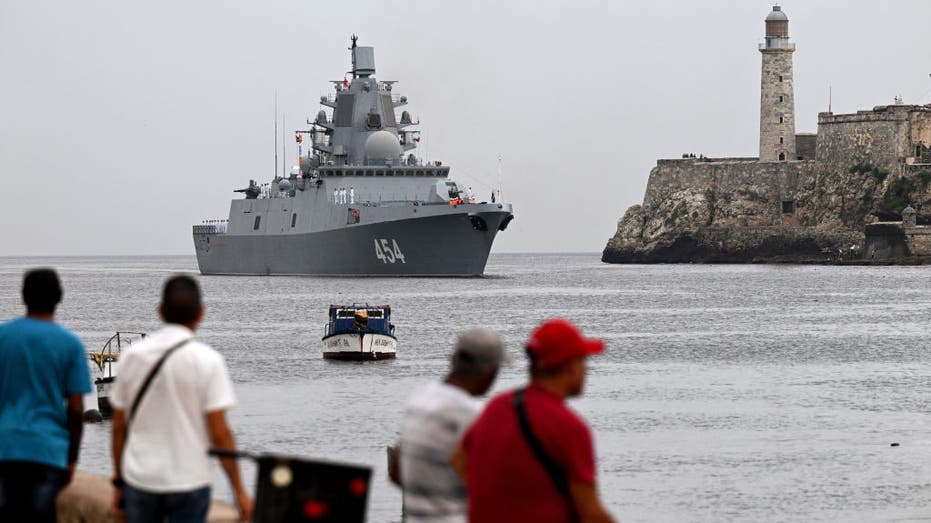Old Cold Warrior and Russian President Vladimir Putin is obsessed with Cuba and Florida. Back in 2018, he released a video of a simulated Russian nuke attack on Miami. With NATO pressuring Russia in the biggest allied exercises since the 1980s, Putin is pushing back with naval drills off Florida.
The Black Sea is no longer safe for Russia’s navy. So, on Tuesday, two of Putin’s best new warships showed up in Cuba, carrying advanced hypersonic missiles.
This being the Russian navy, they wisely brought along an oiler for refueling and a salvage tug, just in case.
RUSSIAN WARSHIPS ARRIVE IN CUBA AHEAD OF MILITARY EXERCISES, TENSIONS WITH WEST OVER UKRAINE
“We’ve been tracking the Russians’ plans for this,” said Sabrina Singh at the Pentagon.
All eyes are on the frigate Admiral Gorshkov, a Stalinist-gray slab of stealthy, modern naval design, and on the guided-missile submarine Kazan. The Zircon missiles they carry can move almost 7,000 miles per hour at sea level.
The Admiral Gorshkov launched in 2018 as the lead ship of her class. No way will Russia risk her in the Black Sea, where Ukraine’s shore defense batteries and drones have already sunk Russian navy ships like the Moskva.
The guided missile submarine Kazan is also new, much quieter, and a step up in capability for Russia. Analysts watched Kazan under construction in the shipyard just like the opening scenes of the classic Sean Connery movie “The Hunt for Red October.” When the nuclear-powered Kazan put to sea in 2021, U.S. Northern Command described the submarine as “on par with ours.”
Both ships carry nuclear-capable Zircon hypersonic missiles. The Zircon missile is a nasty customer. It is a scramjet: a supersonic combustion ramjet, capable of flight at Mach 9 or nine times the speed of sound. The Zircon has the ability to maneuver, which makes it hard to track, and the missile is also capable of carrying a nuclear warhead. The catch? Zircon probably has to slow down to acquire and track to its target. And then it’s easier prey.
Still, Putin adores the Zircon. Back in 2023, he praised Zircon as a “unique weapon” without an “equivalent for it in any country in the world.” The Admiral Gorshkov has also been a primary test platform for the Zircon missile.
After the Havana port call, Russia plans more drills, and when that happens, U.S. ships and planes will make the Russians squirm under constant surveillance.
According to the head of Russia’s navy, the goal of the exercises is “practicing the use of high-precision missile weapons by means of computer modeling.”
Not to worry. A posse of U.S. Coast Guard and Navy ships and planes, with an assist from Canada, is picking up every move of Putin’s tiny task force.
In the skies, the U.S. Navy’s P-8 Poseidon radar plane is watching the Russian captains stir tea on the bridge of their ships. The P-8 is a modified 737 Boeing jet with phenomenal radars and other sensors tuned to track ships and submarines.
The Coast Guard already had ships in place due to the Haiti crisis, so monitoring the Russians was easy. The U.S. Coast Guard National Security Cutter Stone is sleek, fast and new, having been delivered in 2020. With a hull length of 418 feet, it is the largest and most technologically advanced ship type in the Coast Guard, well-armed and expert at enforcing good maritime behavior.
Technically, the Coast Guard belongs to the Homeland Security Department, but in practice, cutters roam the world’s oceans and have a lot of recent experience with the Houthis and the Chinese.
CLICK HERE FOR MORE FOX NEWS OPINION
For surface intercept and missile defense, look to the U.S. Navy’s Arleigh Burke-class Aegis destroyers. Public data showed three of the destroyers, including the USS Delbert D. Black, homeported in Florida, heading toward the Russians. They have all the missile defense systems needed to cue and carry out an effective response.
Beyond question, there are U.S. submarines nearby, too. Of course, all of this is well in range of land-based fighters and bombers. Canada, our partner in defense of North America, also has planes and ships engaged.
On the global stage, Russia’s navy exercises are a deliberate move to make Putin feel like he can conduct limited attacks on America if he so orders. Putin has threatened London and several other NATO allies.
The fact is Putin is not happy. Why would he be? NATO allies are pledging 10 years of support to Ukraine, the Russian offensive near Kharkhiv is stalled out, Ukraine is hitting Russian air defenses, and Russia is becoming a vassal state to China.
Putin thinks he is flexing Russia’s asymmetric capabilities. But all Putin is accomplishing is letting the U.S. get a good tactical update on Russian naval electronic emissions, tactics and how well the Russian sailors handle their ships. Not to mention whatever magic is going on under the seas.
So, just consider the Russian warships drilling off the Atlantic coast as “target practice.”
The outcome of Russia’s drills will be more experience for the U.S. Navy and Coast Guard, to put to use in the Pacific to deter China’s fast-growing navy.


:format(jpeg):quality(80)/wp-content/uploads/2024/06/noul-magazin-romania.jpg)
:format(jpeg):quality(80)/wp-content/uploads/2024/06/dumitru-dragomir-despre-mesajul-nationalei-ce-generatie-de-suflet-o-vrajeala-totala.jpg)
:format(jpeg):quality(80)/wp-content/uploads/2024/06/franta-2.jpg)
:format(jpeg):quality(80)/wp-content/uploads/2024/06/sgr-1.jpg)